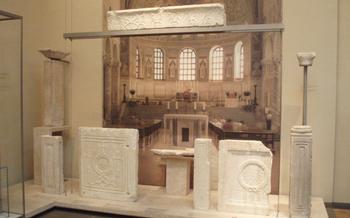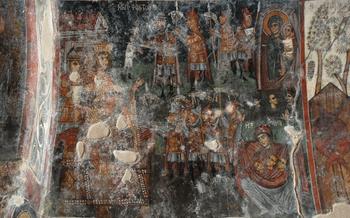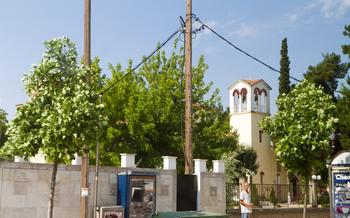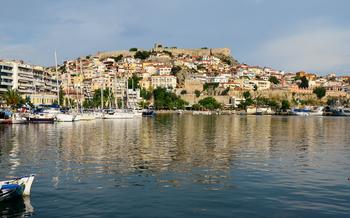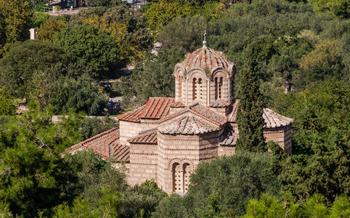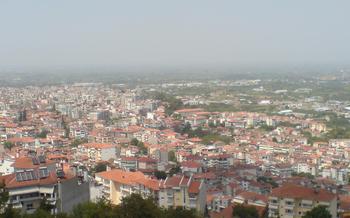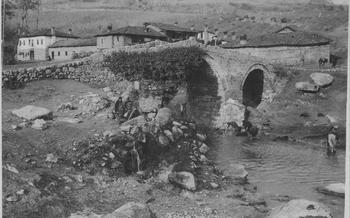
Ecclesiastical Art Museum of Alexandroupoli
- History of the Museum
- Location and Accessibility
- Museum Collection
- Byzantine Icons
- Post-Byzantine and Modern Art
- Religious Vestments and Textiles
- Woodcarvings and Sculptures
- Gold and Silver Artifacts
- Ceremonial Objects and Ritual Implements
- Temporary Exhibitions and Events
- Museum Shop and Publications
- Accessibility and Amenities
- Photography and Social Media
- Insider's Tip: Unveiling the Hidden Gem
History of the Museum
The Ecclesiastical Art Museum of Alexandroupoli stands as a testament to the rich religious heritage of the region. Established in 1980 under the auspices of the Holy Metropolis of Alexandroupolis, this museum is dedicated to preserving and showcasing the sacred treasures and artifacts that bear witness to the deep faith and artistic traditions of the local Orthodox Christian community.
The museum's collection has been meticulously assembled over the years, with contributions from churches, monasteries, and private collections throughout the region. Each piece tells a story, revealing the evolution of religious art and the profound connection between the people of this land and their faith.
One of the most remarkable features of the museum is its collection of Byzantine icons, which offers a glimpse into the exquisite artistry and deep spirituality of this ancient tradition. These icons, with their vibrant colors and intricate symbolism, transport visitors to a realm of divine beauty and devotion.
Location and Accessibility
The Ecclesiastical Art Museum of Alexandroupoli is strategically situated in the heart of the city, making it easily accessible to visitors. Nestled on Patriarch Athanasios Avenue, in close proximity to the city center, the museum is an integral part of the cultural fabric of Alexandroupoli. Its convenient location allows visitors to seamlessly integrate a visit to the museum into their exploration of the city's other attractions.
To reach the museum, visitors can conveniently utilize public transportation. Several bus routes have stops nearby, ensuring easy access from various parts of the city. For those arriving by car, ample parking spaces are available in the vicinity, further enhancing the accessibility of the museum.
The museum is committed to ensuring inclusivity and accessibility for all visitors. Thoughtful features such as ramps and elevators have been incorporated to facilitate wheelchair access throughout the museum's premises. Additionally, wheelchair-accessible restrooms are available for the convenience of visitors with disabilities.
Museum Collection
The Ecclesiastical Art Museum of Alexandroupoli boasts a diverse and impressive collection of ecclesiastical artifacts, icons, and religious objects that span various historical periods. These artifacts provide a glimpse into the rich religious heritage of the region and its profound influence on the local culture.
Icons: The museum houses a significant collection of icons, including exquisite examples of Byzantine and post-Byzantine iconography. These icons are not mere religious objects but also stunning works of art, showcasing the artistic prowess and deep spiritual devotion of their creators.
Manuscripts and Books: Visitors can also admire a collection of ancient manuscripts, illuminated books, and liturgical texts. These rare and precious items offer insights into the region's religious practices and the development of Christianity throughout the centuries.
Metalwork and Jewelry: The museum showcases a variety of intricate metalwork and jewelry, including chalices, reliquaries, and crosses. These objects demonstrate the exceptional craftsmanship and artistry of local artisans and the importance of precious metals in religious rituals.
Textiles: The collection also includes a range of religious textiles, such as vestments, embroideries, and tapestries. These textiles showcase the region's rich textile tradition and the significance of textiles in enhancing the visual and spiritual experience of religious ceremonies.
Sculpture: Visitors can admire a collection of sculptures, including wooden carvings, marble statues, and bronze figures. These sculptures depict religious figures, saints, and biblical scenes, adding a three-dimensional element to the museum's collection.
Byzantine Icons
The Ecclesiastical Art Museum of Alexandroupoli boasts a remarkable collection of Byzantine icons, a testament to the region's rich artistic and religious heritage. These exquisite works of art, created during the Byzantine Empire (330-1453), are renowned for their profound spiritual symbolism, intricate craftsmanship, and enduring beauty.
Among the highlights of the collection is a stunning depiction of the Virgin Mary known as the "Theotokos Hodegetria," which translates to "She who shows the Way." This iconic image, believed to date back to the 13th century, portrays the Virgin Mary holding the infant Jesus in her arms, her gaze gently guiding the viewer's attention towards her son. The intricate details, vibrant colors, and expressive faces of the figures exemplify the mastery of Byzantine iconographers.
Another notable piece is a well-preserved mosaic icon of Saint George slaying the dragon. Created in the 12th century, this dynamic and visually compelling artwork captures the legendary battle between the courageous saint and the fearsome creature. The intricate tesserae, or small pieces of colored glass or stone, create a rich and textured composition, bringing the heroic tale to life.
These Byzantine icons, with their timeless aesthetic and profound spiritual significance, offer visitors a glimpse into the deep-rooted religious traditions and artistic prowess of the Byzantine Empire. They stand as a testament to the enduring legacy of Byzantine art and its profound influence on the cultural and spiritual heritage of the region.
Post-Byzantine and Modern Art
The Ecclesiastical Art Museum of Alexandroupoli also houses a significant collection of post-Byzantine and modern religious art. This section of the museum showcases the evolution of religious art from the fall of the Byzantine Empire to the present day.
Notable examples of post-Byzantine art include intricate icons painted in the Cretan style, characterized by their vibrant colors and expressive figures. These icons provide a glimpse into the artistic and religious climate of the region during the post-Byzantine period.
In contrast, modern artworks in the museum reflect the changing cultural and artistic landscape of Greece. Contemporary artists have reinterpreted religious themes using various media and techniques, resulting in thought-provoking and visually striking pieces.
The post-Byzantine and modern art collection at the Ecclesiastical Art Museum of Alexandroupoli offers visitors a unique opportunity to explore the diverse artistic expressions of religious faith throughout history. These artworks not only showcase the talent and creativity of the artists but also provide insights into the evolving religious and cultural identity of the region.
Religious Vestments and Textiles
The Ecclesiastical Art Museum of Alexandroupoli boasts an impressive collection of intricately designed religious vestments, textiles, and ceremonial garments. These ornate pieces, often adorned with rich embroidery, woven patterns, and gleaming metallic threads, hold deep symbolic and religious significance in Orthodox Christianity.
One of the highlights of the collection is a magnificent bishop's robe, meticulously crafted from opulent velvet and adorned with intricate gold embroidery. The robe's vibrant hues and intricate motifs symbolize the bishop's authority and spiritual status.
Another noteworthy piece is an exquisitely embroidered altar cloth, featuring scenes from the life of Christ and the saints. The vibrant colors and delicate needlework showcase the exceptional craftsmanship of the artisans who created it.
These religious vestments and textiles were not mere decorative elements but played a vital role in enhancing the solemnity and grandeur of religious ceremonies and rituals. They served as a reminder of the divine presence and the sacred nature of the liturgy.
Through these exquisite pieces, visitors can gain a deeper understanding of the rich symbolism and artistry that permeate Orthodox Christian traditions and the important role that textiles played in religious practices throughout history.
Woodcarvings and Sculptures
The Ecclesiastical Art Museum of Alexandroupoli houses an impressive collection of woodcarvings, sculptures, and other three-dimensional artworks that captivate visitors with their intricate details and artistic prowess. These pieces, crafted from various types of wood, showcase the exceptional skills and craftsmanship of the region's artisans.
The woodcarvings range from small, delicate figures to large, imposing sculptures, each one a testament to the artist's mastery of the medium. Intricate patterns, flowing lines, and lifelike expressions characterize these works, creating a sense of awe and wonder among viewers.
Among the highlights of the collection is a stunningly detailed iconostasis, a traditional Orthodox Christian screen that separates the sanctuary from the nave of a church. The iconostasis features a series of carved wooden panels depicting various religious figures and scenes, arranged in a harmonious composition.
Visitors can also admire a collection of sculptures that portray biblical characters, saints, and other religious figures. These sculptures, often life-size or larger, exude a sense of solemnity and reverence, inviting visitors to contemplate their spiritual significance.
The techniques employed in creating these woodcarvings and sculptures vary, with some pieces showcasing the precision of chisel work, while others highlight the fluidity of carving with a knife. The use of different types of wood, such as cypress, walnut, and oak, adds to the diversity and richness of the collection.
These woodcarvings and sculptures play a crucial role in enhancing the visual and spiritual experience of religious spaces. Their intricate details, expressive forms, and symbolic meanings contribute to the overall ambiance of churches and monasteries, creating a sense of awe and devotion among believers.
Gold and Silver Artifacts
The Ecclesiastical Art Museum of Alexandroupoli houses a resplendent collection of gold and silver artifacts that bear witness to the exquisite craftsmanship and artistry of Orthodox Christian metalwork. These precious objects, adorned with intricate designs and shimmering gemstones, hold immense historical and religious significance.
Among the highlights of the collection is an ornate gold chalice, intricately engraved with scenes from the life of Christ. The chalice, believed to date back to the 17th century, showcases the exceptional skill of its creator, who meticulously crafted each detail with precision and artistry.
Another remarkable piece is a silver reliquary, intricately designed to hold the relics of a saint. The reliquary, adorned with delicate filigree work and enamel accents, is a testament to the devotion and reverence with which religious artifacts were created.
These gold and silver artifacts not only serve as stunning examples of craftsmanship but also hold deep spiritual significance within the Orthodox Christian tradition. They represent the sacred vessels used in religious ceremonies and rituals, embodying the divine presence and the connection between the earthly and the heavenly realms.
Visitors to the Ecclesiastical Art Museum of Alexandroupoli are invited to marvel at the beauty and craftsmanship of these precious artifacts, which offer a glimpse into the rich history and traditions of Orthodox Christianity in the region.
Ceremonial Objects and Ritual Implements
The Ecclesiastical Art Museum of Alexandroupoli houses a diverse collection of ceremonial objects and ritual implements that provide a glimpse into the rich traditions and practices of Orthodox Christianity. These sacred objects, imbued with both historical and spiritual significance, play a crucial role in various religious ceremonies and rituals.
Among the notable artifacts on display are intricately decorated chalices, used for the consecration of wine during Holy Communion. These chalices, crafted from precious metals and adorned with intricate engravings, symbolize the blood of Christ and the act of sharing in his sacrifice.
Another highlight of the collection is a set of ornate reliquaries, containers designed to hold the relics or remains of saints and martyrs. These reliquaries, often adorned with jewels and elaborate designs, serve as a testament to the veneration of holy figures and the belief in their enduring presence and intercession.
Furthermore, visitors can admire a collection of ceremonial crosses, which hold a central place in Orthodox Christian liturgy. These crosses, crafted from wood, metal, or ivory, are intricately carved or engraved with religious imagery and serve as a symbol of faith and devotion.
Each of these ceremonial objects and ritual implements carries a unique story and holds deep spiritual meaning for Orthodox Christians. By exploring this collection, visitors gain a deeper understanding of the rituals and practices that shape the religious identity and traditions of the region.
Temporary Exhibitions and Events
The Ecclesiastical Art Museum of Alexandroupoli is not just a static repository of religious artifacts; it is a dynamic space that hosts a variety of temporary exhibitions, workshops, and special events throughout the year. These events offer visitors a chance to delve deeper into the museum's collection, explore new themes, and engage with contemporary artists and scholars.
Temporary exhibitions can range from showcasing the works of local artists to presenting artifacts from other museums or private collections. Past exhibitions have covered topics such as the history of Byzantine iconography, the role of textiles in religious rituals, and the influence of modern art on religious expression.
Workshops and events provide hands-on experiences for visitors of all ages. Visitors can learn about the techniques of icon painting, create their own religious crafts, or participate in discussions with experts on various aspects of religious art and history.
To make the most of your visit, check the museum's website or social media pages for information on upcoming exhibitions and events. These special offerings not only enhance your understanding of the museum's collection but also provide a platform for dialogue, creativity, and community engagement.
Museum Shop and Publications
The Ecclesiastical Art Museum of Alexandroupoli features a well-stocked museum shop that offers a diverse range of souvenirs, books, and other related items for visitors to purchase. These items serve as tangible mementos of their visit and contribute to the museum's sustainability and ongoing mission.
In the museum shop, visitors can find a variety of souvenirs, including postcards, magnets, and replicas of religious artifacts. These items are perfect for those who want to take a piece of the museum home with them or share their experience with friends and family.
For those seeking a deeper understanding of the museum's collection, a selection of books and publications is available for purchase. These publications include catalogs, guides, and research papers that delve into the history, significance, and artistic value of the artifacts on display. These publications are invaluable resources for scholars, art enthusiasts, and anyone interested in learning more about the rich religious heritage of the region.
By purchasing souvenirs and publications from the museum shop, visitors can support the museum's ongoing mission to preserve, showcase, and promote the region's ecclesiastical art. These purchases contribute to the museum's ability to continue offering educational programs, exhibitions, and events that enrich the cultural landscape of Alexandroupoli and beyond.
Accessibility and Amenities
The Ecclesiastical Art Museum of Alexandroupoli is committed to providing a welcoming and accessible environment for all visitors. The museum features a number of accessibility features to ensure that everyone can enjoy the collection, regardless of their physical abilities.
Wheelchair users and visitors with limited mobility will find ramps and elevators throughout the museum, making it easy to navigate the different floors and exhibits. Accessible restrooms are also available for the convenience of all visitors.
For those traveling with young children, the museum offers a variety of amenities to make the visit more enjoyable. Strollers are welcome in the museum, and a changing table is available in one of the restrooms.
A cloakroom is also available for visitors to store their belongings while they explore the museum. And for those who need a break or want to enjoy a snack, a cafe is located on the premises.
With its accessible features and thoughtful amenities, the Ecclesiastical Art Museum of Alexandroupoli ensures that everyone can have a comfortable and enjoyable visit.
Photography and Social Media
The Ecclesiastical Art Museum of Alexandroupoli welcomes visitors to capture the beauty and significance of its collection through photography. However, to ensure the preservation of the artworks and a respectful environment for all visitors, certain guidelines must be followed.
Photography is permitted for personal, non-commercial use only. Visitors are encouraged to use their cameras or smartphones to document their visit and share their experiences with others. However, the use of tripods, flash photography, and any professional photography equipment is strictly prohibited.
To maintain the sanctity of the religious artifacts and the contemplative atmosphere of the museum, visitors are kindly requested to refrain from using their phones for calls or messaging while inside the exhibition halls.
The museum actively encourages visitors to share their experiences and spread awareness about its collection through social media. Visitors are welcome to tag the museum (@ecclesiasticalmuseumalex) and use relevant hashtags (#ecclesiasticalmuseumalex, #religiousart, #byzantineicons) to connect with other art enthusiasts and share their unique perspectives.
By following these guidelines, visitors can help preserve the museum's treasures for future generations while also sharing their appreciation for this remarkable collection with the world.
Insider's Tip: Unveiling the Hidden Gem
Venture beyond the main exhibition halls and discover a hidden treasure within the Ecclesiastical Art Museum of Alexandroupoli. Tucked away in a secluded corner, you'll find a small, unassuming room that houses a remarkable collection of ancient manuscripts. These precious documents, some dating back centuries, offer a glimpse into the rich religious and cultural heritage of the region. From illuminated manuscripts adorned with intricate gold leaf to handwritten texts that tell the stories of saints and martyrs, this hidden gem is a testament to the enduring power of faith and the written word. Don't miss the opportunity to explore this secret chamber and immerse yourself in the wisdom and spirituality of the past.
